The 1960 Jefferson Nickel has enjoyed popularity since its release as it was minted in large quantities. However, although this coin is mostly in circulation, it is still of considerably good value and is worth collecting. Collectors who seek to complete their coin collection search for these coins in their best condition and grade. This article exposes the full price and value of the 1960 Jefferson Nickel in its different grades and condition.
1960 Nickel Value Details
- Category: Jefferson Nickel
- Mints: Philadelphia and Denver
- Total Mintage: 249,689,782
- Face value: Fifty cents ($0.05)
- Observe designer: Felix Schlag
- Reverse designer: Felix Schlag
- Edge: Plain
- Shape: Round
- Diameter: 21.21 millimetres
- Weight: 5 grams
- Thickness: 1.95 millimetres
- Composition: 75% Copper, 25% Nickel
Also Read: 15 Most Valuable Nickels Worth Money
1960 Nickel Value Chart
| Mint | Good | Fine | Extra fine | Uncirculated |
| 1960 P Jefferson Nickel | $0.05 | $0.05 | $0.39 | $1 |
| 1960 P Jefferson Nickel (Proof) | $7 | $8 | $20 | $50 |
| 1960 D Jefferson Nickel | $0.05 | $0.05 | $0.39 | $0.2 |
1960 Nickel Value and Varieties
1960 P Jefferson Nickel
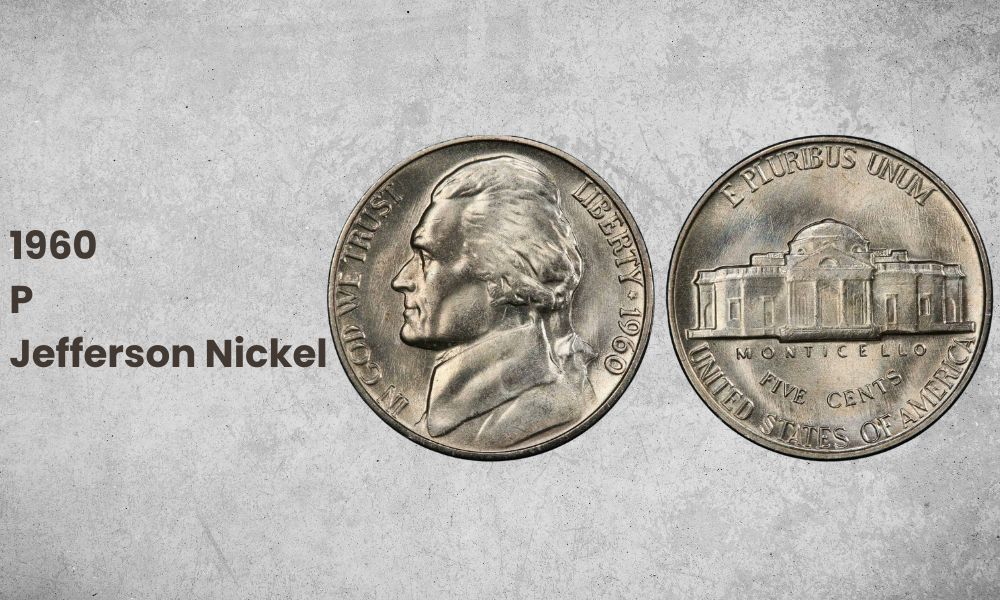
- Category: Jefferson Nickel
- Mint: Philadelphia
- Mint mark: No mint mark
- Total Mintage: 55,416,000
- Face value: Fifty cents ($0.05)
- Designer: Felix Schlag
- Edge: Plain
- Shape: Round
- Diameter: 21.21 millimetres
- Weight: 5 grams
- Thickness: 1.95 millimetres
- Composition: 75% Copper, 25% Nickel
The 1960-P Nickel was minted in Philadelphia in over 55 million quantities released into circulation. And these coins have been in the coin market for years, having a high survival rate. However, due to its being in circulation for a long time and high mintage, most of the coin species found in markets are considerably low in condition.
Thus, coins in perfect/mint state are rare and hard to find, especially those in “Full step” grading (the Monticello with 5-6 steps). Also, the coin’s condition determines its value and price, so while an average 1960-P will cost between $0.05 and $1, those of higher grades can cost up to $14 in coin markets. And it is reported by PCGs that the coin currently has no grade higher than MS 67. A 1960 Nickel DMS 65 with full step was sold for about $1400.
1960 P Jefferson Nickel (Proof)
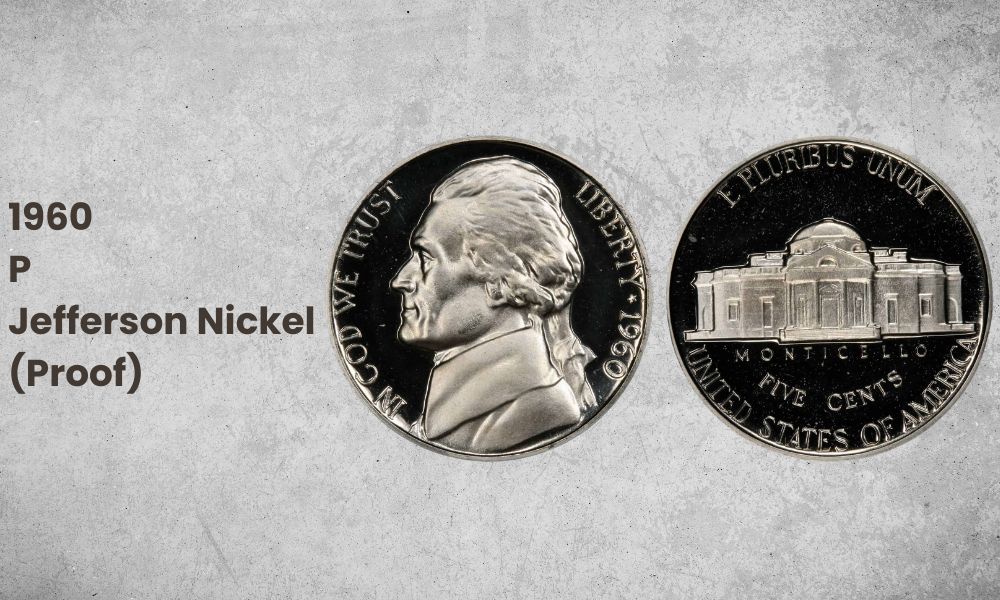
- Category: Jefferson Nickel
- Mint: Philadelphia
- Mint mark: No mint mark
- Total Mintage: 1,691,602
- Face value: Fifty cents ($0.05)
- Designer: Felix Schlag
- Edge: Plain
- Shape: Round
- Diameter: 21.21 millimetres
- Weight: 5 grams
- Thickness: 1.95 millimetres
- Composition: 75% Copper, 25% Nickel
The Philadelphia proof had the lowest production of the three varieties, with 1.6 million proof coins, and like the 1960-P, it also has no mint mark. These coins were minted primarily for collectors and were not released into circulation. Thus, the coin is rare and is more expensive than the other two 1960 Nickel varieties.
Furthermore, the 1960-proof Nickel is more desired because of its attractiveness and defined details. This coin’s price ranges from $1 to $70 and more, depending on its condition and grade. For instance, a proof coin graded at proof 69 deep cameo, a nearly perfect grade, was sold for over $2800.
1960 D Jefferson Nickel
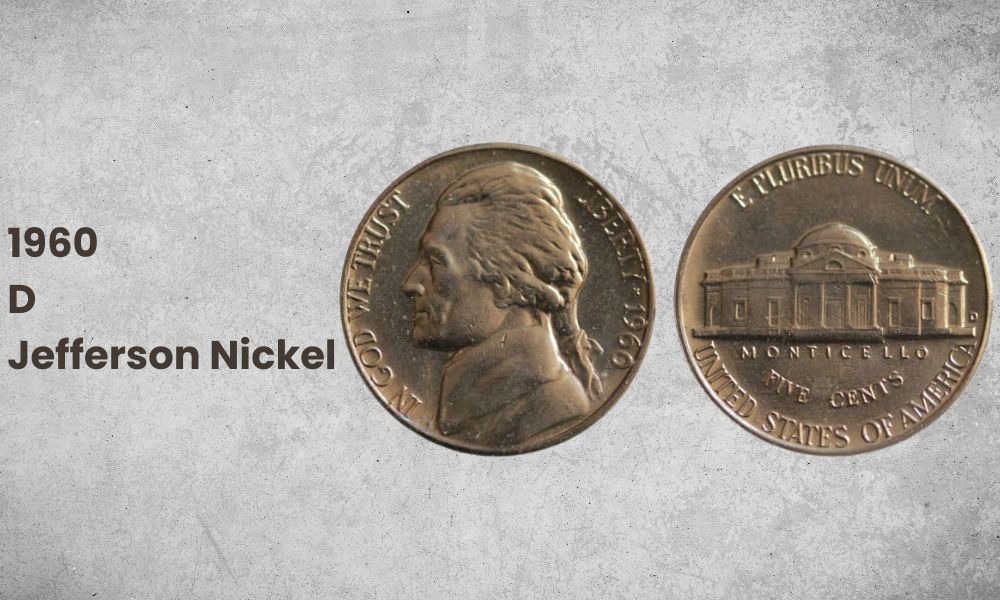
- Category: Jefferson Nickel
- Mint: Denver
- Mint mark: D
- Total Mintage: 192,582,180
- Face value: Fifty cents ($0.05)
- Designer: Felix Schlag
- Edge: Plain
- Shape: Round
- Diameter: 21.21 millimetres
- Weight: 5 grams
- Thickness: 1.95 millimetres
- Composition: 75% Copper, 25% Nickel
The 1960 D Jefferson Nickel was the coin variant struck in Denver and had the highest production of the three, with over 100 million coins minted. The coin is easily identifiable by the “D” mint mark on the reverse on the right side of the Monticello close to the rim. Its price ranges between $0.05 and $50, but prices differ per grade and are worth more on auctions. For instance, a 1960 D Nickel was sold at MS 66 for over $500.
Mostly, collectors purchase these coins to complete the year’s collection. And luckily, the coin can be easily seen in any grade so desired with exceptions to a few rare and high-graded ones.
Also Read: Top 110 Most Valuable Nickels Worth Money
1960 Nickel History
The Jefferson Nickel was first minted in 1938 to replace the Buffalo Nickel. Due to the Buffalo Nickel design not being ultimately liked and often situations of die breaking because of its design, the US immediately moved to replace it when it was eligible to be changed (being struck for 25 years). The US president, Franklin Roosevelt, then proposed the Jefferson Nickel as a worthy replacement featuring the portrait of the third American president, Thomas Jefferson.
In January 1938, the US mint announced a competition for a sculptor to design the new coin, and the winner was to be given a prize of $1,000. The competitors had to fulfill specific requirements to stand a chance to win the prize:
- A design of Thomas Jefferson’s portrait on the obverse
- A portrayal of his mansion, Monticello was to be placed on the reverse
The competitors had until April 15 to make their submissions, and various artists made their entries to be reviewed by the judges: the Mint Director and three other sculptors. By April 24, Felix Schlag was pronounced the winner, and his design was picked amongst many others. However, the mint called for changes to the design before production, including Schlag’s depiction of a tree near the Monticello and the Roman-style lettering used in the design. The designer adjusted the design as required, and it was eventually approved.
Therefore, the coin’s obverse depicts Thomas Jefferson’s portrait facing left, an inscription of “IN GOD WE TRUST” along the left side of the rim, “LIBERTY” on the right, and the year of minting, 1960. On the reverse, the coin shows the front view of Monticello with the name spelled underneath the image. Under it reads the coin’s value, “FIVE CENTS”, and the “UNITED STATES OF AMERICA”, while on the top of the coin is the Latin inscription “E PLURIBUS UNUM”. The coin’s mint mark, “D” or no mint mark, is depicted on the right side of the Monticello.
However, in 2005, the Nickel’s obverse design was changed and made by Joe Fitzgerald, which Jamie Franki later redesigned in 2006. The Jefferson Nickel is composed of 75% copper and 25% nickel.
Also Read: Top 19 Most Valuable Jefferson Nickels Worth Money
1960 Nickel Grading
Besides knowing the different variations of the Nickel, it is crucial to understand the grading process and the coin conditions. Coin grading companies use the Sheldon grading scale, which ranges from poor (p-10) to mint state (MS 70). In addition, certain qualitative words are also used to identify the coin’s grades. Here’s how grading works:
- Uncirculated: this coin is in perfect condition, with most of its features and details in bold. These elements, including areas on Jefferson’s face like his eyebrows and hair, are keenly visible. Also, the coin still maintains its lustre and brightness.
- Extra fine: As the coin begins to circulate, certain high-contour areas lose their lustre and start to flatten. Although the damages on the coin are not easily seen, you may notice a slight change in colour and shine. However, a coin in this grade is still of considerable value.
- Fine: In this grade, the coin has sustained noticeable wear, including flatness in high areas like Jefferson’s hair, eyebrow, cheek and jaw. Although the face has a few bold details, the coin is traded at a lower premium.
- Good: Here, the wears on the coin have caused details to be majorly faint as important details have flattened and lustre lost. This is the lowest coin grade and is scarcely worth much due to its bad condition.
Watch this comprehensive video on how to grade the 1960 Jefferson Nickel.
1960 Nickel Errors
While collectors have their eyes on exceptional coin variants and high grades, they also look out for error coins. This is because error coins are mostly considered worth more than standard coins since they are unique. And with over 200 million Jefferson Nickels minted in 1960, it is almost impossible not to have some coins with errors. Here are some examples of the 1960 Jefferson Nickel errors:
1. Clipped Planchet Error
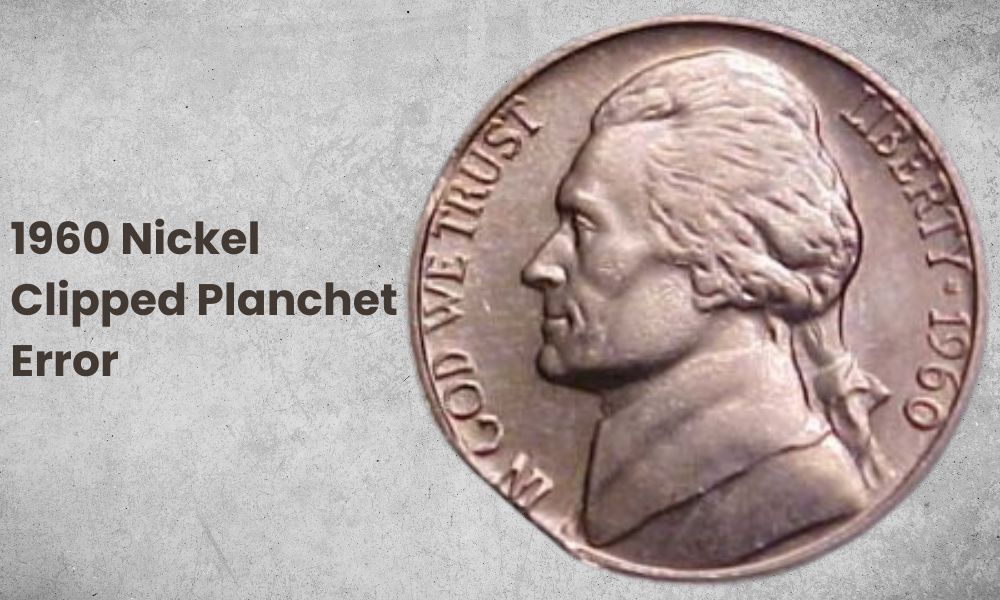
This error may occur while the planchet is cut, as a part of the coin is mistakenly cut, causing the edge to be clipped. This coin error was sold for $11.
2. Die Chip Error
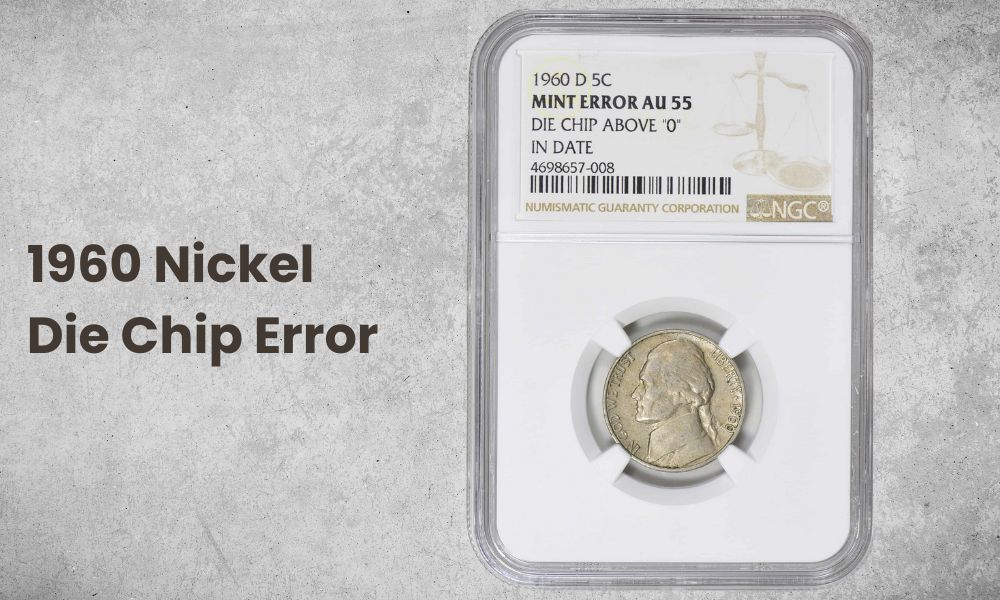
When minting equipment is used for an extended period without proper maintenance, it may get damaged and affect the coin being struck. Sometimes, the die breaks during mintage and the cracks from the damaged die are struck into the coin. This error was sold for about $14 in the 1960 D. This coin may range from $15 to $18.
3. Off-centre Error
The planchet may move between strikes or be incorrectly placed. Thus, the die will hit the planchet at the wrong angle and cause the coin to be improperly struck. Where this happens, the coin depicts an off-centre look, and the coin’s design is shifted to a part, leaving a space in the coin.
4. Doubled Die Error
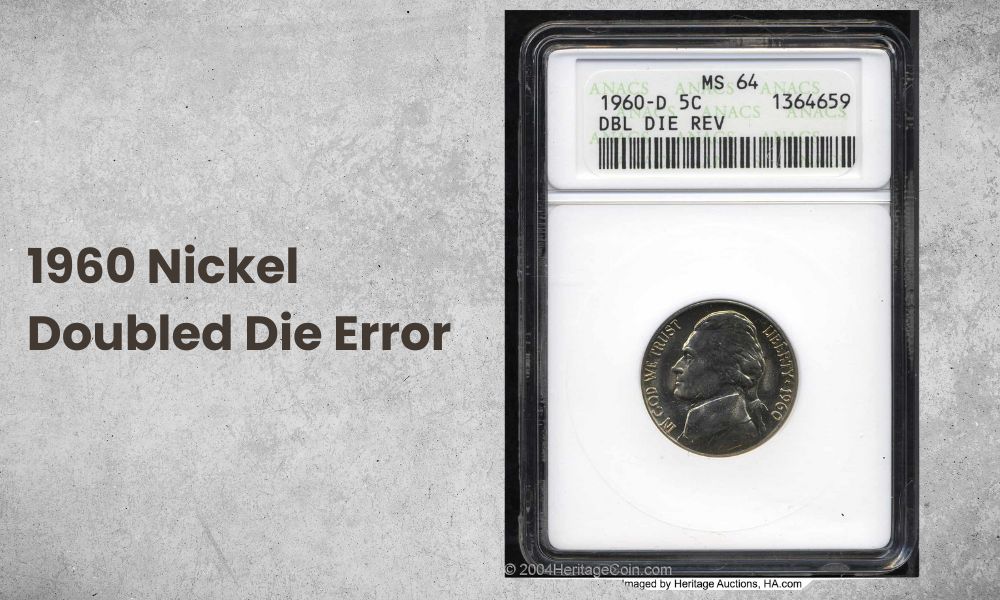
This is one of the most common coin errors where the die strikes a coin twice. This may happen because of a dysfunctional die or the die moving between striking. This error results in the coin’s details, as the lettering, portrait and mint mark appear twice. However, this error might be difficult to detect since the doubling is only a layer above the normal one. But the more noticeable the doubling is, the more valuable the coin. This error coin is worth between $9 and $25.
5. Defective Planchet Error
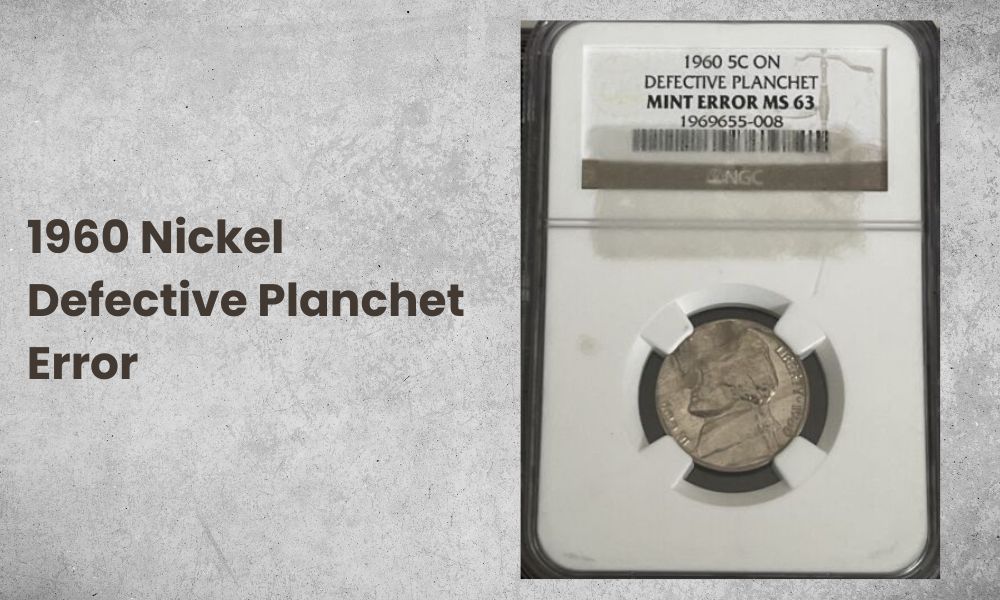
This error is caused by a damaged planchet which caused a significant part of Jefferson’s face to be smudged. This coin was sold for about $100.
6. Broad Struck on a Split Planchet
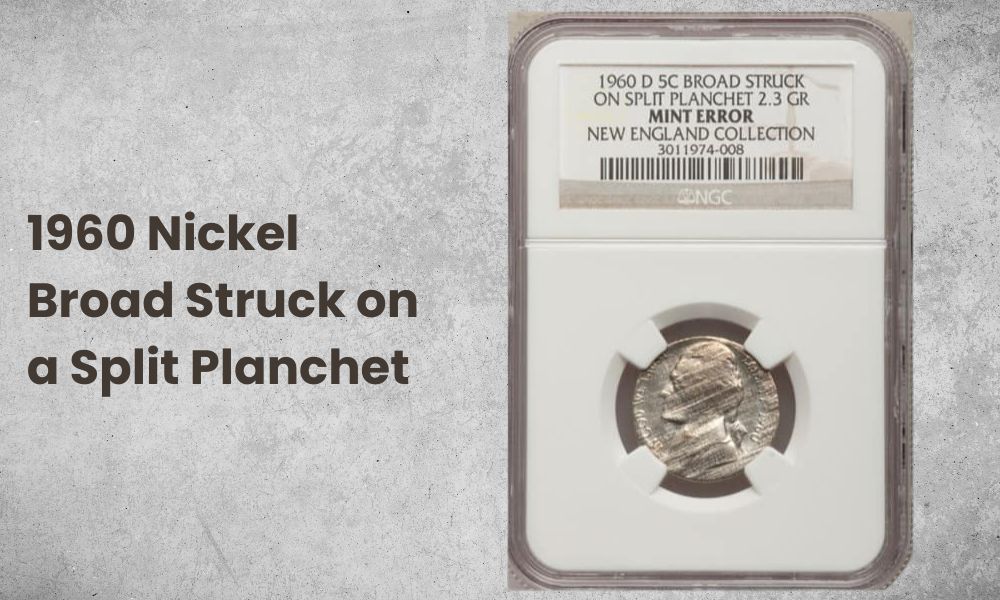
This occurred on a 1960 D Jefferson broad struck on a split planchet causing the coin to look almost damaged. The broad stroke is visible on the reverse. It was sold for over $125.
7. Nickel Struck on a Penny
The 1960 Jefferson Nickel was struck on a penny planchet that is a one-cent planchet instead of its standard planchet. This coin was sold for about $470.
8. Quadrupled Die Reverse
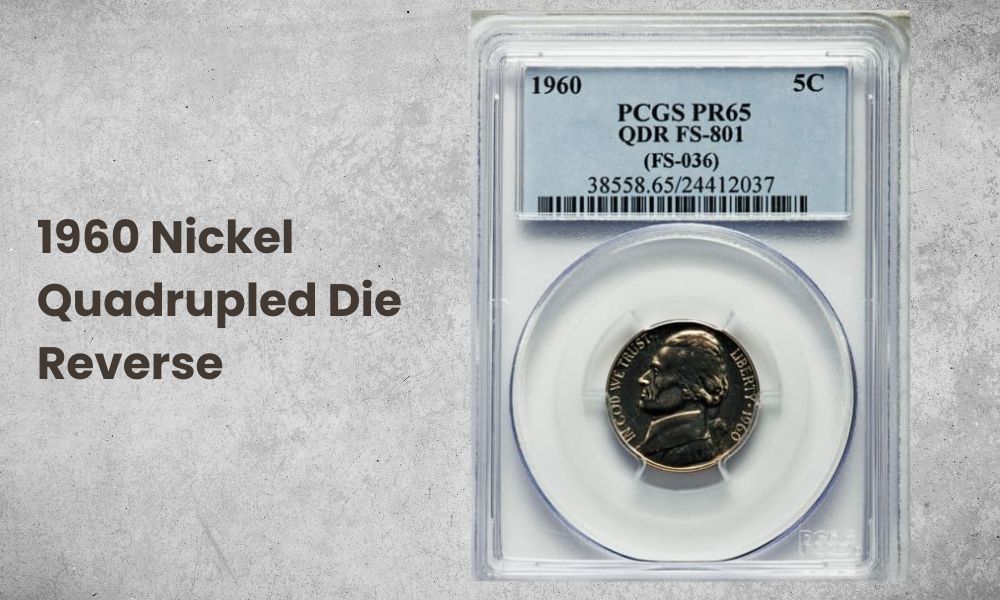
This error is a die being struck on one coin four times, causing details to show four times. This coin was sold on a 1960-proof Nickel for $1,400.
You may find more 1960 Nickel rare varieties worth a lot in the video below.
FAQs
1. Is a 1960 Nickel Rare?
Generally, the 1960 Jefferson Nickel was struck mainly in over 200 million coins. However, specific varieties of Nickel are rare, namely the 1960-proof coin exclusively minted for collectors, and Full step coins, which are costly variants.
2. Is a 1960 Nickel silver?
The 1960 nickel has a metal composition of 75% copper and 25% nickel. However, from 1942 to 1945, the Nickel was struck in 56% copper, 25% silver, and 9% manganese and were nicknamed “Wartime Nickels”.
3. What Makes A 1960 Nickel Valuable?
Like every other coin, factors such as the coin’s variety, popularity, error, and condition influence the value of the coin. But, most importantly, the coin’s condition is the basis on which it is graded and how much it is worth.
4. Where is the Mint Mark on a 1960 Nickel?
The mint mark can be found on the coin’s reverse just beside the Monticello. It is, however, inconspicuous but is not unnoticeable. But only the Denver mint has a mint mark, and like the Philadelphia mint tradition, there isn’t a mint mark on the coin’s variant. So, the 1960 nickel either has a “D” mint mark or no mint mark.
Conclusion
The 1960 Jefferson Nickel is one of the coins of the Jefferson nickel category with a wide mintage. Regardless of its popularity, the coin is significantly valuable and is sought after in especially high grades and uniqueness. Also, the coin’s design is identifiable by Jefferson’s portrait on the obverse and Monticello on the reverse, so ensure you know what you’re being offered before purchasing. You must also understand the coin grading system and the varieties to make the right purchase decisions.
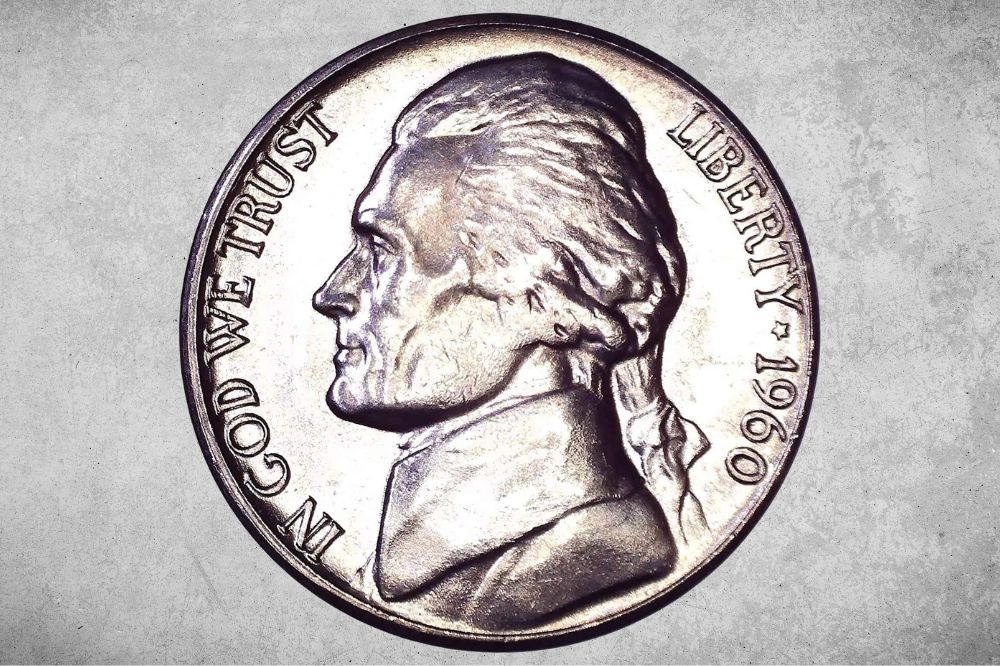
I have one 1960 nickel w/o letter but it looks like 3D’s face pop out
Soundin likea perdy coin ya gots there spanky….When ya get 3-D’s at the family reunion you be seeing in 3D’s